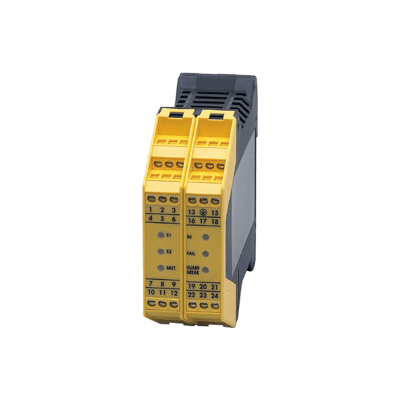What Is a Safety Controller?
 A safety controller is a device that determines whether a machine is safe to operate and controlled based on signals received from safety input devices.
A safety controller is a device that determines whether a machine is safe to operate and controlled based on signals received from safety input devices.
It can prevent a machine from starting, or force a machine to stop if it is unsafe to do so. Safety details are obtained by the use of electronic components and software based on functional safety standards
Uses of Safety Controllers
Safety controllers are used to monitor input devices, output devices, and the safety controllers.
They receive signals from input devices while the machine is running. Examples of input devices are emergency stop pushbutton switches or light curtains. The input device outputs an ON/OFF binary signal, and depending on the state of this signal, the safety controllers send a forced stop control signal to the output device or monitor the state of the input/output device.
If a machine failure occurs, self-diagnosis detects the failure and shuts off the machine’s power by stopping the output. In the event of an abnormality, output devices can be safely stopped even if the operator is in a dangerous condition.
Principle of Safety Controllers
Hard-wired devices have been mainstream for safety reasons, but now that it is possible to configure safety circuits, electronic devices can be assured of the same quality as hard-wired devices.
The internal structure of safety controllers is designed and manufactured based on the concept of functional safety. The CPU performs mutual checks and back-checks on the input and output circuits, while the CPUs diagnose and monitor each other inside the device. Through these checks, the machine operates only when normal.
Types of Safety Controllers
Safety controllers can be classified according to whether they are programmable or not, as follows:
1. Programmable Type
Also called programmable safety controllers, these controllers allow the creation of safety control programs that are specific to the machine. Therefore, they can flexibly respond to cases in which complex logic needs to be constructed.
2. Non-programmable Type
Generally called safety relay units, these products range from those that support one pair of inputs and outputs each to those that have multiple inputs and outputs and can be used to build simple safety control circuits.
Depending on the product, safety control circuits can be easily built without programming, allowing for total and partial shutdown.
Additional Information on Safety Controllers
1. Safety Controllers Safety
To prove that a safety controller is safe, it must be based on a functional safety standard.
Functional safety standards are based on the idea that things will break, and people will fail. The measures that reduce the allowable risk are determined in relation to the scale of damage caused by failures and errors.
The level of countermeasures according to the scale of damage is called the safety integrity level. Safety Integrity Levels (SIL) are divided into four levels, with Safety Integrity Level 4 requiring the highest level of countermeasures and Safety Integrity Level 1 requiring the lowest level of countermeasures.
Based on functional safety standards, it is defined “as determining the level of countermeasures according to the magnitude of damage, and using records such as design basis and manufacturing process to explain to a third party that the countermeasures correctly reflect the level of damage.”
2. The Program Used in Safety Controllers
There are four types of safety controller programs, namely: ladder, flowchart, stepladder, and SFC (Sequential Function Chart). The ladder method is the most commonly used of the four, And it is called a ladder diagram or ladder program because its description format resembles a ladder.
A relay is an electronic component that switches ON or OFF by an external electrical signal. In a relay sequence, an input relay controlled by an external input, such as a sensor, and an output relay controlled by an external output, such as a motor, turns on or off the output relay when the conditions of a timer or counter are met.
The disadvantage of ladder programming is that it is difficult to modify the system because the programming software differs from one safety controller’s manufacturer to another.
3. Functions Required of Safety Controllers
At a minimum, the safety controller must meet functional safety standards, such as those listed below:
Investigate the Cause of a Forced Machine Shutdown
In some cases, an input device or safety controllers may determine that a machine is in danger and force it to stop, even though it is not in fact in danger. The system must be able to investigate the cause in a short period to determine if the machine was really in danger or if it was based on a malfunction.
Ease of Operation.
When a safety controller is purchased, wiring and program implementation are required. If these tasks require a lot of man-hours when starting up or reassembling a production line, production efficiency will be reduced.